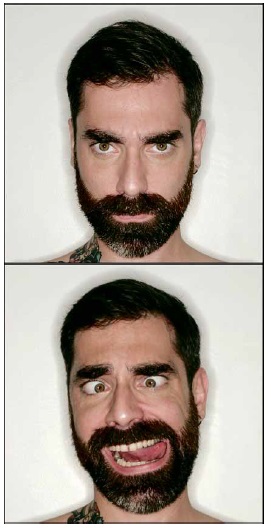
In 2006, French photographer Romain Rivierre was working on the portrait of film director Terry Gilliam for Premiere. The movie magazine was supposed to review “Tideland,” a fantasy-thriller starring Jeff Bridges.
At the studio, Rivierre made his subject comfortable by telling the director how much he had admired “Monty Python,” the British comedy-sketch show in which Gilliam was an original member. As they went into a light banter, Gilliam started to ham in front of the camera.
The result was a series of expressions that ranged from formal to wacky, captured in film format. However, the photos were never published since “Tideland” received negative reviews, and it had only a short theater run in France.
Nevertheless, the experience became the seed of Riverre’s project, “Facétieux,” which literally means facetious or comical. His current exhibit at the A Space Gallery consists of a series of portraits of 27 individuals from the culture and fashion scene. The photos aim to take candid expressions of the sitters—rocker Pepe Smith; French Ambassador Gilles Garachon and his wife Isabelle; model-actress Solenn Heussaff and her brother, restaurateur Erwan; models Borgy Manotoc and girlfriend Georgina Wilson; stylist Noel Manapat; designers Rhett Eala and Kate Torralba, et al.
Rivierre explains that he has always loved parody. For the CD cover of a French pop-rock group, he once photographed a model wearing a wet T-shirt that clung to her bosom.
In the subsequent CD spread, he made fun of the cover by using a fat, hairy man wearing the same wet T-shirt that hugged his gut.
Beyond the quirky expressions, his photos are out to make a statement—that the seemingly old-fashioned film photography maintains its allure in this digital age. He used a Hasselblad camera with a medium format for film, which made the process slower but more precise. Since it took a longer setup, it allowed him to interact with his sitters and study them longer. With Garachon, for instance, the envoy shared his passion for films and playing the acoustic guitar.
Old school
Rivierre studied at Lycée Quinalt in Paris where he was trained in the old-school photography, using the now classic analog camera. This type of camera needs more accuracy than the digital. It requires knowledge of storing, handling and loading delicate film; precision in wielding the camera as well as processing film in the dark room. Although he was taught to manually retouch photos, he was never adept at it. He vowed that he would make sure the subject was picture-perfect to minimize or avoid any enhancements.

He prefers the challenges of using film over digital wherein photographers can consume hundreds of frames of the same subject and pose that are usually wasted.
“Within a roll of film, you are given a limited number of frames to photograph with, compelling you to responsibly calculate what you want to capture,” said Rivierre.
With those constraints, the photographer becomes more mindful of the creative process instead of getting caught up in the conveniences of a digital camera.
Moreover, film teaches patience, leaving the photographer in anticipation of the outcome of his work after days of processing. Sometimes prints bring unexpected results such as deviances in color, texture and grain that can transform an ordinary image into art, he said.
As digital cameras have become more accessible, many people tend to pass themselves off as “professional photographers” without learning the proper techniques. Rivierre clarifies that the digital camera is useful for journalistic coverages because of speedy processing, but for artistic and commercial works, the digital medium tends to make the users “lazy.” They compensate by correcting the flaws through “digital editing.”
Still, Rivierre uses the digital camera for his magazine and assignments. He arrived in the Philippines in 2009 to photograph transsexuals for Paris Match on a story of homosexual rights. He also covered Jewelmer, the French-Filipino South Sea pearl company, also for Paris Match, and women’s trafficking, for French Marie Claire.
During the 2009 elections, he took a portrait of then senatorial candidate Bongbong Marcos for the French Catholic publication La Croix, which did a story on the return of the Marcoses to power.
“In the end, a good picture is all about what the eye sees. You could even make an arty picture with an iPhone,” says Rivierre.
A Space is at 110 Legazpi St., Makati City; tel. 8460856.














































